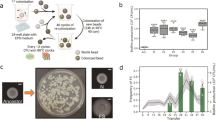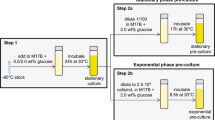Abstract
The process of dissociation into variants that differ in colony morphology occurring in batch cloned cultures of two Bacillus thuringiensis strains belonging to different subspecies was studied at optimal and elevated temperatures. An increase in the cultivation temperature to 40°C resulted in an increase in the fraction of R variants to 100% after 72 h of cultivation of either of the strains. This increase was not due to the selection of forms with greater resistance to elevated temperature. The level of resistance to elevated temperature was determined by the strain genotype and did not correlate with morphological characteristics of the colonies.
Similar content being viewed by others
REFERENCES
Talalaev, E.V., Investigation of Intrastrain Variability of the Populations of Pathogenic Bacilli of the Thuringiensis Group, Mikroorganizmy v zashchite rastenii ot vrednykh nasekomykh (Microorganisms Used for Plant Protection from Pests), Irkutsk, 1978, pp. 3-12.
Izakson, I.S. et al., Phage Resistance and Virulence of Industrial Strains of Bacillus thuringiensis var. galleriae, Mikrob. Prom., 1976, no. 6, pp. 28-31.
Anufriev, L.F. and Zhdanov, I.N., The Effect of Certain Factors of the Virulence of Bacillus thuringiensis var. dendrolimus 49/6, Biologiya mikroorganizmov i ikh ispol'zovanie v narodnom khozyaistve (Biology of Microorganisms and Their Use in the Industry and Agriculture), Irkutsk, 1981, pp. 95-99.
Azizbekyan, R.R., The Entomopathogenic Bacteria Bacillus thuringiensis and Their Phages: Genetic and Physiological Characteristics, Doctoral (Biol.) Dissertation, Moscow, 1980.
Mil'ko, E.S. and Egorov, N.S., Geterogennost' populyatsii bakterii i protsess dissotsiatsii (Heterogeneity of Bacterial Populations and the Process of Dissociation), Moscow: Mosk. Gos. Univ., 1991.
Golovlev, E.L., Metastability of the Bacterial Phenotype, Mikrobiologiya, 1998, vol. 67,no. 2, pp. 149-155.
Belyakov, V.D., Kaminskii, G.D., and Zharikova, G.G., The Hypothesis of Directed Self-Rearrangement of Microbial Populations and Its Significance for General Biology, Zh. Mikrobiol., Epidemiol. Immunol, 1985, no. 1, pp. 93-100.
Yousten, A.A., A Method for the Isolation of Asporogenic Mutants of Bacillus thuringiensis, Can. J. Microbiol., 1978, vol. 24,no. 4, pp. 492-494.
Shamshina, T.N., Konstantinova, G.E., Kuznetsova, N.I., and Azizbekyan, R.R., An Extracellular Sporulation-Suppressing Factor Produced by Bacillus thuringiensis, Biotekhnologiya, 1994, no. 5, pp. 11-13.
Author information
Authors and Affiliations
Rights and permissions
About this article
Cite this article
Sekerina, O.A., Chemerilova, V.I. On the Adaptive Nature of the Dissociation Process in Bacillus thuringiensis . Microbiology 72, 613–617 (2003). https://doi.org/10.1023/A:1026059704183
Issue Date:
DOI: https://doi.org/10.1023/A:1026059704183




